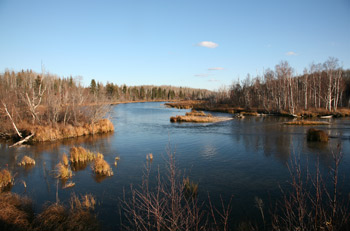|

Over the years, the Silva Forest Foundation has prepared numerous papers explaining our ecosystem-based conservation planning methodology. The most current and extensive explanation of this methodology is contained in our book, Maintaining Whole Systems on Earth’s Crown. You can find more information and order the book here.
For the history of how we developed our methodology, we invite you to read the articles below.
Ecosystem-based Planning: Principles and Process, 2002
This brief paper outlines the goals, principles, and a process for preparing ecosystem-based conservation plans. Ecosystem-based plans are necessary in order to protect and maintain ecological health and biological diversity at all scales, from small land and water ecosystems to large landscapes. Human cultures and economies depend on healthy ecosystems and biological diversity, in other words, on natural capital. Planning human activities that protect, maintain, and, where necessary, restore ecosystem health and biodiversity is the basis for developing sustainable human economies and cultures. Such activities are ecologically responsible, because they ensure that ecological processes continue to support the full range of life.
Ecosystem-based planning is a system that may be effectively applied in unmodified to highly modified landscapes; and may be used for a wide range of purposes from conservation area design to resource development, settlement design, and urban planning.
An Ecosystem-based Approach to Forest Use: Definition and Scientific Rationale, 1997
This paper provides a description of an ecosystem-based approach to planning and carrying out human activities. Understanding the relationships between ecosystems, human cultures, and economies is at the heart of an ecosystem-based approach. Both common sense and scientific knowledge lead us to the understanding that economies are subsets of human cultures, and human cultures are subsets of ecosystems. Therefore, if our activities protect the functioning of ecosystems, we will protect human cultures, and if we protect human cultures, we will protect or sustain our economies.
Ecosystem-based planning and management can be defined as a way of relating to and using the ecosystems we are part of in ways that ensure the protection, maintenance, and, where necessary, restoration of biological diversity, from the genetic and species levels to the community and landscape levels. An ecosystem-based perspective works at all scales from the microscopic to the global.
Wholistic Cost Benefit Analysis, revised 1996
Conventional cost/benefit analysis as applied by government and industry tends to value short term monetary returns on investment at the expense of ecological and community integrity.
We believe that the goal of sustainable resource development is to maintain an even flow of benefits and costs over the long term. However, this will never be achieved by allowing today's benefits to outweigh tomorrow's costs. Our method of cost/benefit analysis balances the priorities in time and space. Short and long-term local costs (ecosystem degradation and community instability) are as important as short-term distant benefits (corporate profits and returns to non-resident shareholders). This paper outlines the methods we utilize in cost benefit analyses in our diverse projects.
Landscape Analysis: Step by Step Methodology, 1993
The methodology described in this document is a step by step guide to the methods used by the SFF to carry out landscape analysis and forest use planning, using maps and air photos. The landscape analyses which the SFF commonly performs have two broad aims:To reach an understanding of basic landscape patterns and landscape ecological processes in a forest area, and then propose a protected network of landscape units which will protect and maintain these patterns and processes after human disturbance and resource use.
To allocate or zone forests by best use. Forest use categories frequently include culture zones, ecologically sensitive protected zones, wildlife protection zones, wilderness zones, recreation and tourism use zones, and timber management zones.
The analysis methods described can help to create forest use plans which will protect the landscape ecology, or the connections and interactions in the forest landscape, during and after human use of forests. The planning processes outlined in this paper, coupled with ecologically responsible stand level practices, are positive steps towards achieving this goal.
Landscape Analysis and Planning: Overview, 1992
Landscape analysis is the process of describing and interpreting the landscape ecology of an area. Resource patches and a landscape network of connecting corridors are identified, described and classified. The patterns which are detected can then be used to assess the impacts of past disturbance (natural or human), and to plan and regulate further human resource use.
Landscape planning identifies and protects the landscape components necessary to maintain the stand ecology and the landscape ecology of forest areas during and after human use. "Human" is an important variable in this statement - the ecology of the world would be in excellent shape without human intervention. Still, man is a part of the total planetary ecosystem; landscape planning and landscape ecology provide our current best hope of living within the ecological limits imposed by the planetary ecosystem.
Silva advocates the use of landscape planning through systems which are variously called wholistic forest use or ecologically responsible forest use. These terms describe a system of landscape level planning which respects both the ecological limitations to human use and the established cultural uses of forests. The goal is to achieve balanced use and stewardship of the forest - to ensure that an intact, functioning, diverse forest landscape remains after human use of forest resources.
|

